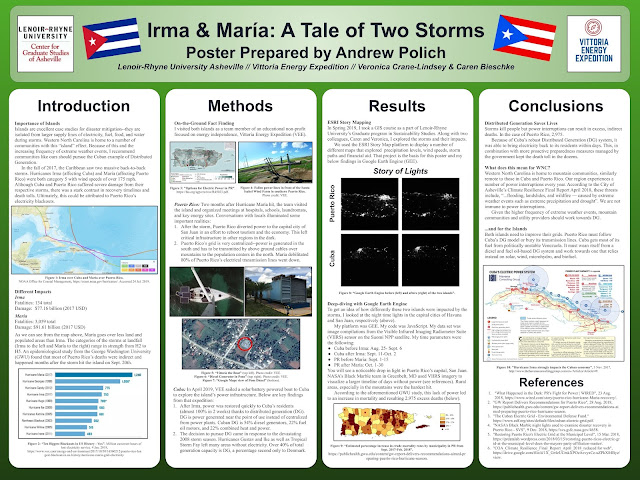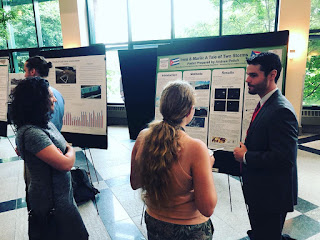 |
| In all of its glory, the poster. |
AT A GLANCE
 |
| Proud and exhausted all at once. |
I even got to moderate the Campus Initiatives in Sustainability working group. The discussions were enriching and challenging!
MORE BACKGROUND
Islands
are excellent case studies for disaster mitigation. Around storms, they are
isolated from larger supply lines of fuel, food, and water. In the fall of
2017, the Caribbean saw two massive back-to-back storms. Hurricanes Irma and
Maria were both Category 5 and affected densely populated areas. But there were
stark contrasts in preparedness and response, especially with electricity.
Because Puerto Rico fell short on both fronts, Hurricane Maria took a toll of
around $100 billion and 3,000 lives--magnitudes more than what Irma was for
Cuba.
 |
| I'm in a grey suit. Source. |
Two
classmates and I explored the two storms through maps. We looked at storm
paths, precipitation, wind speeds, and Doppler radar images. What shocked us
was how similar the storm maps were. One of the most compelling maps we
produced used before-and-after night time satellite imagery. We learned how to
use Google Earth Engine to show how steady the lights were in the capital
cities (Havana and San Juan). Those findings are on slide 8 of this older post.
 |
| Presenting to fellow participants and the general public. |
With such
similar storms, how could the costs be so different? Why was Puerto Rico’s
power restoration timeline so much longer than Cuba’s? We found that it came
down to distributed energy. After a devastating storm a decade earlier, Cuba
decided to transition from centralized electricity to decentralized (or
distributed). The government quickly installed diesel-electric generators all
across the island. Even if transmission lines were severed, power losses would
be localized and limited.
Puerto
Rico’s electricity was maintained by the utility, PREPA. The central grid was
destroyed during the storm and electricity was out for many months.
Transmission lines were cut and power generation facilities rendered
inoperable. The slow restoration of electricity proved to be more deadly than
the storm’s primary hit.
With a
team at Vittoria Energy Expedition (an educational non-profit), I traveled to
both Puerto Rico and Cuba to learn more about the different electricity
systems. I interviewed power providers, communities, and government officials.
I documented and mapped out what I learned.
 |
| Chatting with Amory Lovins of the Rocky Mountain Institute. |
On both
islands, I learned how the people came to make do with limited equipment and
use any resources at their disposal. But it was this ingenuity matched with
effective government programs that made Cuba weathering Irma a success story.
Neighboring islands and coastal communities can learn a lot from the King of
the Caribbean in preparedness, resilience, and sustainability.
No comments:
Post a Comment